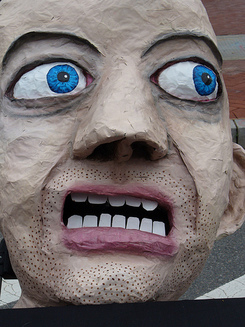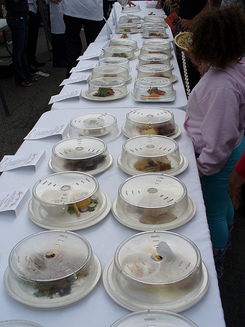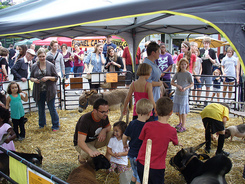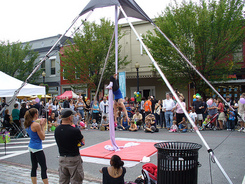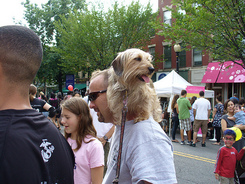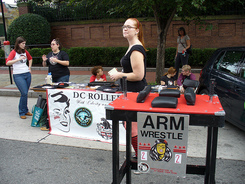
Saturday’s annual Barracks Row Fall Festival brought the community together for art, fitness, food, and music.
Belga Cafe and The Ugly Mug drew revelers with their beer and food offerings, while dozens of military chefs participated in a cook-off. New York Trapeze School aerialists performed in front of large crowds all afternoon, and the Marine Corps recruited volunteers to perform in the pull-up challenge.
Many children played with bunnies, goats, and other animals at the petting zoo; other kids took to the rowing machines provided by the Anacostia Community Boathouse Association. DC Rollergirls skated through the crowds, trying to wrangle up some arm wrestling challengers. Art representing multiple disciplines was on display, including metal working, photography, sketches, paintings, and sculptures.
There were a few standout moments: Signing my life away to the Marines when completing the pull-up challenge; gulping a Yeungling Oktoberfest from The Ugly Mug; and pigging out on a slider, mini hotdog, salad, and cookie plate from Matchbox.
All together, it was a fun way to spend the afternoon.

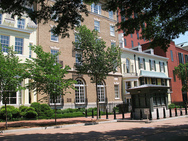
Photo by Mr. T in DC on Flickr.
At last night’s NCPC panel, “Redefining Security a Decade After 9/11,” we were reminded that on security, Americans are a “cantankerous bunch.” According to Brian Jenkins of RAND Corporation, US residents demand to feel 100% safe at all times at no cost to their way of life.
Jenkins, joined by architect Thomas Vonier and landscape architect Alan Ward, addressed this dilemma and others in a discussion on balancing physical security needs with good urban design. When it came to how much security is appropriate, though, the panelists diverged in their recommendations.
Vonier’s talk seemed to encourage a “whatever it takes” mentality on introducing both visible and concealed security measures into the urban space. He embraced the use of “choke points,” or highly supervised, securitized points that all people entering a site must pass through. Vonier lauded Lafayette Square as a successful example of an urban control zone.
In contrast to Vonier stood Ward, who turned to the Washington Monument as an ideal example of a minimalist solution to security concerns. The Monument received a security facelift in 2003 with the addition of sunken walls that naturally curve around the base of the hill on which the Monument stands, providing additional security without encroaching upon visitors’ privacy.
Unlike Vonier, Ward seemed more inclined to respect historical precedents and maintain the natural order of a space to the greatest extent possible. He lamented the 18-foot descent that pedestrians endure when approaching the Capitol Visitor Center, a sensation he described as the antithesis to the entry experience one expects of such a grand building.
Jenkins and Vonier both suggested civic authorities reduce security risks from vehicles by creating pedestrian roadways with reduced or no car and truck access. London developed the “Ring of Steel” after a series of IRA attacks. This is a perimeter of Closed-captioned Television (CCTV), police, and bollards within the City of London, Greater London’s financial district. According to Jenkins, as a result of the “Ring of Steel,” the streets have been “pedestrianized,” and commerce is thriving.
Ward, however, disagreed with adopting a similar approach. “We don’t have the density of pedestrians” to eliminate cars from certain roads, he said. Ward also suggested that the economy would not support such changes in traffic patterns, which could “kill businesses.”
The panelists bandied about a number of solutions to the question of how to simultaneously provide both security and amenity. Vonier referred to the classic necessity of more eyes on the street to increase vigilance against threats. He suggested that police and civic authorities encourage proprietors to take ownership of the sidewalks and streets in front of their businesses, creating a “defensible space.”
During the question and answer session, Jenkins suggested that in order to make the public more accountable for security, governments must improve education and communication, helping individuals to better understand policy decisions and security protocol while empowering them to be more vigilant.
Disappointingly, some of the pricklier subjects, such as congestion pricing, closed circuit surveillance, and defense against airborne security threats were mentioned in brief but not explored much further.
Many questions still remained unanswered. How can design engage the public in the provision of their own security? At what point did Americans become passive potential victims, as many of the latest security measures suggest? Which works better: the prototypical Parisian cafe-style of surveillance, or the large setbacks and empty spaces prevalent in front of federal buildings?
Nobody seemed fully equipped to provide answers, largely because the issue frequently turns into a matter of subjective opinion, as the talks showed. At the very least, however, the panelists could all agree that many existing security features around DC, like the Jersey barriers outside of the Federal Aviation Administration’s building, can and should be improved to reflect stronger urban design and a better connection to the pedestrian experience.
Top image: Photo by Mr. T in DC on Flickr.
